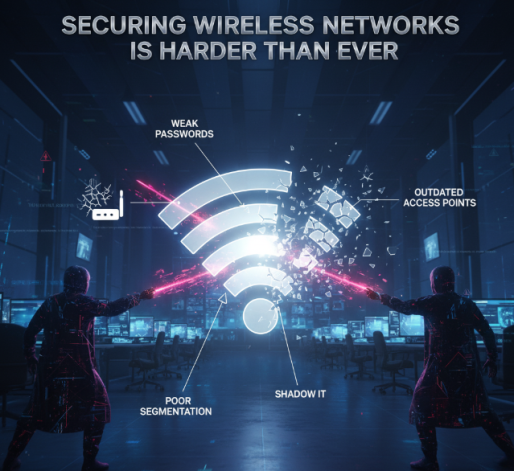Introduction: Why Securing Wireless Networks Is Harder Than Ever
Most organizations rely on wireless connectivity for daily operations—but WiFi is also one of the easiest attack surfaces for threat actors to exploit. Weak passwords, outdated access points, poor segmentation, and shadow IT can expose an enterprise to breaches, data loss, and compliance failures. As environments become more mobile and cloud‑centric, a secure wireless setup is no longer optional—it’s foundational.
This guide breaks down how to build a secure, scalable wireless environment using modern best practices, and where a partner like OmniLegion can support your engineering, implementation, and ongoing lifecycle needs.

What a Modern, Secure Wireless Setup Requires
A strong wireless environment combines infrastructure, configuration, monitoring, and governance. Below are the core pillars every IT team should follow.
1. Start with Enterprise‑Grade Wireless Design
Your network must support density, roaming, and interference management.
Key steps:
- Conduct a predictive or onsite wireless survey
- Place APs based on RF patterns, not convenience
- Align with standards from NIST and Microsoft (for secure architecture principles)
- Use WiFi 6/6E for enhanced throughput and security
2. Strengthen WiFi Security with Modern Authentication
Legacy PSKs (pre‑shared keys) don’t cut it.
Stronger options:
- 802.1X + RADIUS authentication
- Certificate‑based identity
- Role‑based access policies tied to user groups
- Guest networks with time‑bound or SMS‑based access
3. Apply Network Segmentation and Zero Trust Principles
Segmentation prevents attackers from pivoting laterally.
Practical segmentation models include:
- Separate SSIDs for corporate, guest, IoT, and BYOD
- VLAN assignments per user or device type
- Firewall rules enforcing least privilege
- Zero Trust posture with continuous identity validation
4. Monitor, Patch, and Optimize Continuously
A secure wireless design can degrade fast without governance.
Use this checklist:
- Monthly firmware patching for APs and controllers
- Continuous RF monitoring to detect rogue access points
- Automated configuration backups
- Logging integrated with SIEM tools
5. Support Operational Efficiency with the Right Talent
Enterprise wireless design requires specialized engineering expertise—often difficult to hire or maintain internally.
OmniLegion helps organizations fill these gaps with:
- Pre‑vetted IT engineers (apply as an engineer)
- Wireless lifecycle management and support (get IT help)
- Vendor selection for APs, controllers, NAC, and monitoring tools (see case studies)
FAQs About Building a Secure Wireless Environment
1. What is the most important component of WiFi security?
Identity‑based authentication (802.1X) paired with segmentation is the strongest foundation for enterprise WiFi security.
2. How often should an organization update its wireless infrastructure?
Most companies refresh wireless systems every 4–6 years to keep pace with standards, density needs, and security protocols.
3. What’s the difference between guest and corporate SSIDs?
Corporate SSIDs authenticate users through identity. Guest SSIDs should be isolated, bandwidth‑limited, and time‑restricted.
4. How do I protect IoT devices on WiFi?
Segment IoT onto its own VLAN or SSID with strict east‑west firewall rules.
5. Do I need WiFi 6 or 6E for security?
Both improve performance, but 6/6E also supports stronger encryption and better handling of dense environments.
A Secure Wireless Environment Starts with Smart Design
Whether you’re upgrading legacy WiFi, expanding for hybrid work, or building a Zero Trust wireless foundation, you don’t have to do it alone.
If your organization needs design support, engineering talent, or help modernizing infrastructure, consider partnering with OmniLegion. Their advisory team and technical experts can guide you from assessment to implementation.
Contact OmniLegion to explore your next steps.

